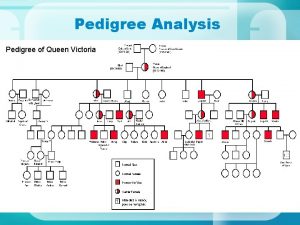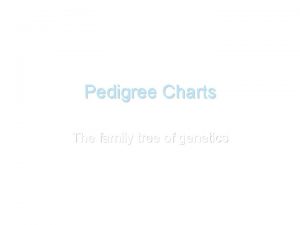Pedigree Analysis Pedigree of Queen Victoria Have you







- Slides: 7

Pedigree Analysis Pedigree of Queen Victoria Have you ever seen a family tree… do you have one? ? Graphic representation of family inheritance.

What is a pedigree? Shows a pattern of inheritance in a family for a specific trait (phenotype) Genotypes can usually be determined Why would we want to use a pedigree in genetics? To track the occurrence of diseases such as: ◦ Cystic fibrosis – 1/2500 – mucus accumulates (white North Amer. ) ◦ Tay-Sachs disease – lipids accumulate in CNS (Jewish) ◦ Phenylketonuria – missing enzyme causes problems in CNS (Nordic/Swedish)

The Symbols used: Roman Numerals indicate generations Children of a generation are in order from left to right and numbered

Sample pedigree: How many females show the trait being studied? What is the sex of offspring III-9? How many offspring did the generation I parents have? What is the difference between the II-3 & 4 and IV-2 & 3?

Inheritance patterns: Autosomal dominant: 1. The disease can be passed from the father to the son , this never happens with X-linked traits. –Example: Polydactyly 2. The disease can occur in three consecutive generations, this never happens with recessive traits. 3. Males and females are affected, with roughly the same probability.

Inheritance patterns: Autosomal recessive 1. Males and females are equally likely to be affected. 2. The trait is usually found in siblings, not parents of affected or the offspring of affected. 3. Is more common than the general population when consanguinous mating occurs (think inbreeding of dogs) –Cystic fibrosis –Tay-Sach’s disease

Inheritance patterns: Sex-linked recessive conditions 1. The disease is never passed from father to son. 2. Males are much more likely to be affected than females. 3. All affected males in a family receive the trait through their mothers. –Examples: –Colour-blindness –Duchenne Muscular Dystrophy –Hemophila












